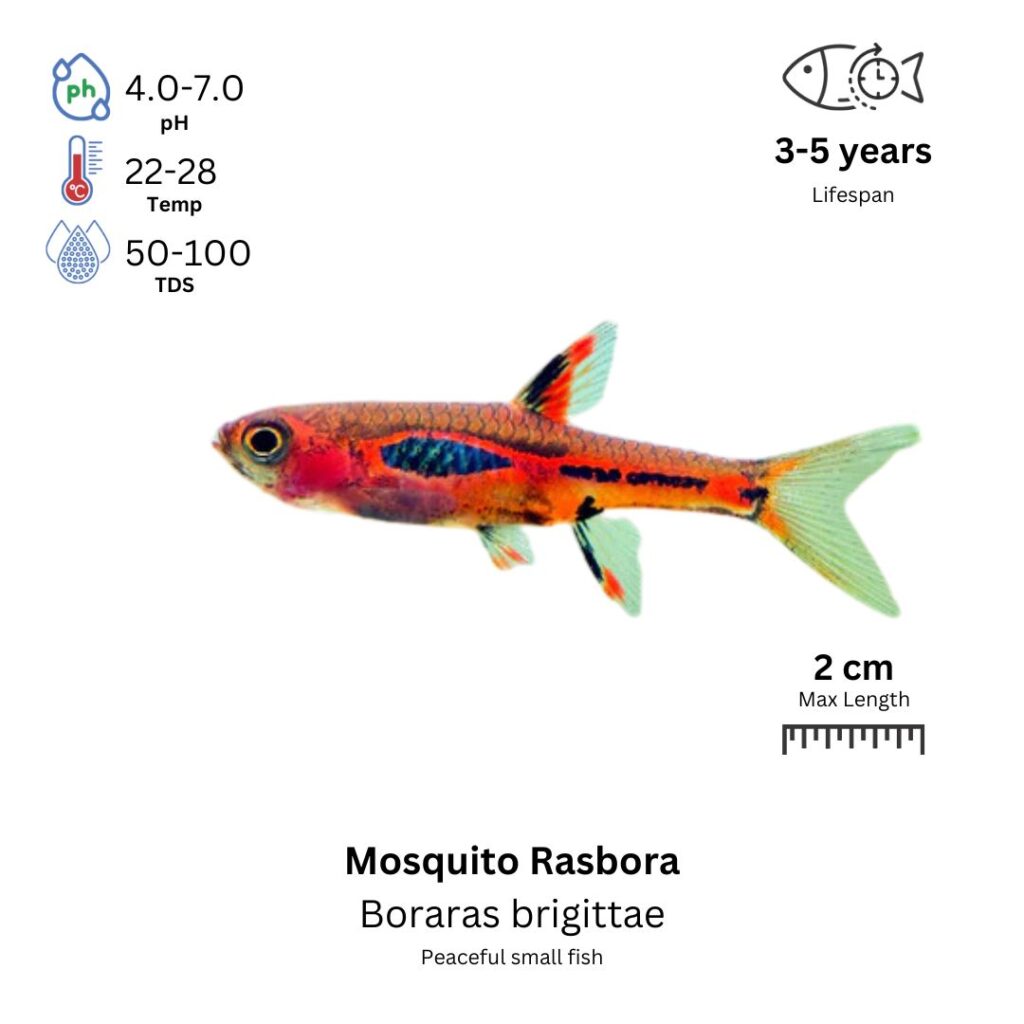Mosquito Rasbora
Boraras brigittae

Description
The Mosquito Rasbora is a tiny, vibrant fish that is known for its bright red-orange body and the contrasting black markings along its body, which become more pronounced when the fish are well-fed and healthy. They have a sleek, slender shape and a peaceful, shoaling nature. Despite their small size, they are active swimmers and do best in groups. These fish are often found darting around the tank, schooling in the middle and lower sections of the aquarium. Their peaceful demeanor and small size make them a popular choice for nano aquariums.
Habitat Origin
Native to Southeast Asia, particularly in the slow-moving waters of Borneo and Sumatra, where they inhabit densely vegetated streams and rivers.
Aquarium
Ideal Number in Aquarium: At least 6-8 individuals for optimal schooling behavior.
Favorite Food

Mosquito Rasboras are omnivores and will eat a variety of foods, including high-quality flake food, small pellets, and live or frozen foods like micro worms, daphnia, and brine shrimp. They also appreciate plant matter, such as finely chopped spinach or algae wafers.
Behavior:
Mosquito Rasboras are peaceful, non-aggressive fish that do well in community tanks with other small, peaceful species. They are schooling fish and feel safest when kept in groups. Due to their small size, they are better suited to aquariums with other small fish. They are active but prefer to stay near the bottom or middle of the tank, foraging for food. They are not fin-nippers, making them ideal tank mates for peaceful community setups.
Special Care:
These fish require stable water parameters, particularly soft, acidic water. It’s important to keep their environment clean, so regular water changes and good filtration are necessary. A densely planted tank with hiding places such as caves and plants will help them feel secure. They prefer calm waters with low to moderate flow.
Compatibility with Other Fish:
Yes, they are excellent tank mates for other peaceful species such as small tetras, shrimp, and other nano fish. Avoid keeping them with larger, more aggressive fish that may see them as food. Their tiny size makes them vulnerable to being bullied by larger species, so ensure that the tankmates are compatible in size and temperament.
Breeding Tank Setup
A separate breeding tank is essential when breeding Mosquito Rasboras to prevent egg predation and maintain stable water conditions. A 5-gallon tank (19 liters) is suitable for a small group, while a 10-gallon tank (38 liters) is better for multiple pairs. Maintain pH 6.0–7.0, temperature 24–28°C (75–82°F), and hardness 4–8 dGH. Use a gentle sponge filter or small internal filter to provide aeration without creating strong currents. Provide fine gravel or bare bottom, and add soft-leaved plants like Java moss, Anubias, or Java fern for spawning surfaces. Floating plants like Hornwort help diffuse light and provide cover for fry. Lighting should be moderate with a 10–12 hour day/night cycle.
Conditioning the Breeders
Condition your Mosquito Rasboras with a varied, high-quality diet. Feed tropical micro pellets or flakes, along with protein-rich live or frozen foods like brine shrimp, daphnia, or microworms. Offer vegetable-based options such as finely chopped spinach, blanched peas, or spirulina. Perform 25–30% weekly water changes, and a 50% water change before breeding, paired with a slight temperature increase, can simulate natural triggers for spawning.
Spawning Process
Spawning usually occurs in the early morning, especially after a water change and temperature rise. Males become more vibrant and chase females as part of courtship. Females lay 30–60 sticky, transparent eggs, which adhere to plant leaves or surfaces. After spawning, immediately remove all adults to prevent them from consuming the eggs. A peaceful, undisturbed tank environment is critical for egg development.
Fry Development
Eggs hatch within 24–36 hours, depending on temperature. Fry are very small and delicate at first. Feed them infusoria or commercial liquid fry food for the first few days. Once they grow, gradually introduce baby brine shrimp, microworms, or finely crushed flakes. Maintain clean water with small (10–20%) water changes every 1–2 days, and avoid overfeeding to prevent ammonia buildup. Stability in temperature and water quality is key to fry survival.
Tips
Mosquito Rasboras reach sexual maturity at 6 months, but breeding is more reliable with 1-year-old, healthy specimens. Males are slimmer, more vividly red, and especially colorful during courtship, while females are rounder with duller coloration. Avoid stress from sudden changes, overcrowding, or aggressive tank mates. Keep the tank quiet and stable to maximize breeding success and fry health.
